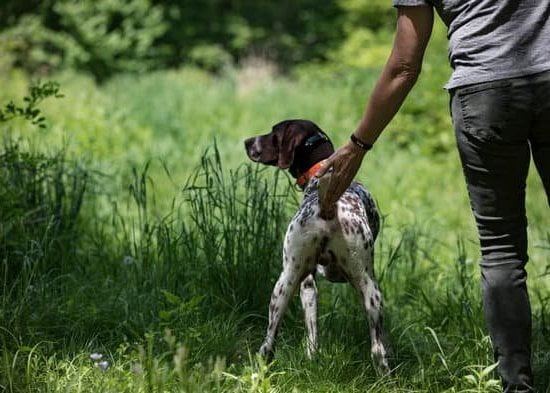In the world of dog training, dealing with dominance issues is a common challenge faced by owners. Whether your dog displays aggressive behavior, shows signs of being territorial, or constantly tries to be in control, understanding how to train them from being dominating is crucial for a harmonious and balanced relationship. This article will provide you with a comprehensive guide on how to address dominance in dogs and transform them into well-balanced companions.
Before delving into the training techniques, it’s important to first understand what dominance means in the context of dogs. Dominance refers to an innate behavioral trait where dogs establish a hierarchical order within their social groups. While this instinctual behavior may have served a purpose in wild canines, it can result in unwanted and problematic behaviors in our domesticated pets. By recognizing and addressing dominant behaviors early on, we can prevent these issues from escalating further.
Addressing dominance issues through training is not just beneficial for the owners but also for the overall well-being of the dog. Unaddressed dominance problems can lead to various negative effects such as increased aggression, destructive behavior, and even strained relationships between the owner and their furry friend. By taking proactive steps to reestablish yourself as the pack leader, set clear boundaries and rules, and utilize positive reinforcement techniques, you can transform your dominant dog into a well-balanced companion.
Throughout this article, we will explore various techniques and strategies that can help you establish yourself as an effective leader while maintaining a loving bond with your dog. From recognizing dominant behaviors to seeking professional help if necessary, each step is crucial in addressing dominance issues successfully. With patience, consistency, and determination, you can transform your dominating dog into a trusted and obedient companion that brings joy and harmony into your life.
Recognizing Dominant Behaviors in Dogs
Understanding and recognizing dominant behaviors in dogs is the first step towards addressing dominance issues and effectively training your dog. By being able to identify these behaviors, you can take appropriate action to establish yourself as the pack leader and create a well-balanced relationship with your furry companion.
Common signs of dominance in dogs include:
Resource Guarding
Dominant dogs may exhibit resource guarding behavior, such as growling or snapping when someone approaches their food, toys, or resting area. This behavior demonstrates a sense of ownership and an unwillingness to share.
Pushiness and Demand Barking
Dogs that frequently jump on people, push their way through doors before others, or engage in demanding behaviors like excessive barking are displaying dominant tendencies. They assert themselves by seeking attention or control over their environment.
Ignoring Commands
A dominant dog may ignore commands from their owner because they believe they have higher authority. This disobedience can be a sign that the dog does not respect their owner’s leadership role.
Differentiating dominance from aggression or fear is important for effective training. While dominant behavior stems from a desire for control, aggression is characterized by intent to harm, and fear results from anxiety and insecurity.
To determine whether a behavior reflects dominance or another underlying issue, it is essential to evaluate the context surrounding the behavior. Consultation with a professional dog trainer or veterinarian can provide further guidance in accurately identifying dominant behaviors in your dog.
By understanding and recognizing these behaviors, you will be better equipped to address them during training sessions. Next, we will delve into the negative effects that unaddressed dominance issues can have on both your pet’s wellbeing and your relationship with them.
The Negative Effects of Unaddressed Dominance Issues
Unaddressed dominance issues in dogs can have negative effects on both the dog and their owner. It is important for owners to understand and address these issues to prevent potential consequences and strain in the relationship between them and their furry companion.
Potential Consequences of Allowing Dominance to Persist
Allowing dominance to persist in a dog can lead to a variety of negative consequences. One major consequence is that it can result in an unsafe living environment for both the dog and those around them. A dominant dog may become more likely to display aggressive behaviors, which can pose a danger to other animals or people in their vicinity. Additionally, unchecked dominance can also lead to destructive behaviors such as excessive chewing or territorial marking.
Another consequence of unaddressed dominance issues is the potential strain it puts on the relationship between the owner and the dog. A dominant dog may challenge their owner’s authority, leading to frustration, resentment, and even fear on the part of the owner. This strained dynamic can make it difficult to establish trust and create a strong bond with the dog.
Relationship Strain Between Owner and Dog
When a dog displays dominant behaviors that go unaddressed, it often results in an imbalanced relationship between the owner and the dog. The owner may feel powerless or constantly undermined by their own pet, leading to feelings of frustration or inadequacy. On the other hand, the dominant dog may become increasingly frustrated due to lack of clear direction from their owner, leading them to act out even more.
This strain in the relationship can affect various aspects of daily life together, including training sessions, walks, or simply spending quality time together. When an owner feels overwhelmed by their dominant dog’s behavior, they may start avoiding certain activities or interactions that would otherwise strengthen their bond. By addressing these dominance issues and establishing a healthy hierarchy within the household, owners can improve not only their dog’s behavior but also the overall quality of their relationship.
By recognizing the potential consequences and relationship strain caused by unaddressed dominance issues, owners can better understand the importance of training their dog to be less dominant. In the next section, we will explore how to establish yourself as the pack leader and assert your authority in a confident and assertive manner.
Establishing Yourself as the Pack Leader
Establishing yourself as the pack leader is crucial when training a dominant dog. Dogs are pack animals by nature and naturally look for guidance and leadership. By assuming the role of the pack leader, you can effectively address dominance issues and ensure a well-balanced relationship with your dog.
To establish yourself as the pack leader, it is essential to be confident and assertive in your interactions with your dog. Dogs respond best to leaders who are calm, consistent, and in control. When interacting with your dog, maintain a confident posture, use clear and authoritative commands, and avoid any signs of hesitation or uncertainty.
Techniques such as basic obedience training can also help establish your leadership role. Teach your dog fundamental commands like sit, stay, and come, consistently reinforcing these commands through positive reinforcement techniques. This not only helps to build trust but also strengthens your position as the one in charge.
Setting clear boundaries and rules is another important aspect of establishing yourself as the pack leader. Dogs thrive on structure and routine, so it’s vital to provide them with consistent guidelines for behavior. Clearly communicate expectations to your dog and enforce rules consistently. Using visual aids such as signs or markers can help remind both you and your dog of these boundaries.
Establishing Yourself as the Pack Leader
- Be confident and assertive in your interactions
- Use clear and authoritative commands
- Engage in basic obedience training
- Consistently reinforce rules and expectations
- Use visual aids to remind both you and your dog of boundaries
Remember that being the pack leader does not mean resorting to harsh or aggressive methods. It’s about earning respect through consistency, fairness, and positive reinforcement techniques. By assuming this role effectively, you can guide your dominant dog towards becoming a well-balanced and obedient companion.
Setting Clear Boundaries and Rules
One of the most important steps in training a dominant dog is setting clear boundaries and rules. Establishing consistent and firm boundaries helps your dog understand what behavior is acceptable and what is not. Without clear rules, a dominant dog may continue to assert their dominance and engage in undesirable behaviors.
Consistency is key when it comes to setting boundaries for a dominant dog. Dogs thrive on routine and consistency, so it’s important to enforce the rules consistently across all family members and situations. Inconsistency can lead to confusion and can reinforce unwanted behaviors.
To effectively set boundaries, start by identifying specific behaviors that you want to address. For example, if your dog tends to push other pets out of their way during mealtime, establish a boundary by teaching them to wait patiently until everyone has finished eating. Use clear and consistent verbal cues or hand signals to communicate these boundaries.
It’s also helpful to establish rules for appropriate behavior in different situations. For instance, you might have a rule that your dog must sit and stay before being allowed inside the house or before going for a walk. Creating these clear expectations helps the dog understand what is expected of them in various contexts.
| Benefits of Setting Clear Boundaries | Techniques for Setting Boundaries |
|---|---|
| 1. Allows for better communication between owner and dog | 1. Consistent use of verbal cues or hand signals |
| 2. Provides structure and security for the dog | 2. Reward-based training for desired behavior |
| 3. Helps reinforce owner’s position as the pack leader | 3. Consistency in enforcing the rules across all family members |
Consistency is Key
Consistency plays a crucial role in retraining a dominant dog. Dogs thrive on routine and structure, so it is important to establish and maintain consistent rules and expectations. By being consistent with your training methods and responses, you can prevent confusion and reinforce positive behavior.
One way to achieve consistency is by ensuring that all members of the household are on the same page when it comes to training. It’s essential to have everyone follow the same guidelines and enforce the same rules consistently. This will help your dog understand what is expected of them and minimize any mixed signals they may receive.
Consistency also applies to how you respond to your dog’s behaviors. For example, if you want your dog to stop jumping on people, it’s important that everyone in the household responds in the same way. If one person allows the behavior while another reprimands the dog for it, this inconsistency can confuse your dog about what is acceptable behavior.
In addition to consistency in rules and responses, it’s also important to be consistent with training sessions. Regular practice sessions will help reinforce desired behaviors and give your dog a predictable routine. Consistency can also help your dog generalize their training to different environments or situations.
To maintain consistency in training sessions, consider creating a daily schedule for training activities. Allocate specific times each day for training exercises or obedience practice. Set clear goals for each session and ensure that everyone involved follows through with the planned activities.
By remaining consistent throughout all aspects of training, from establishing boundaries to utilizing reinforcement techniques, you can help your dominant dog understand their place within the family pack structure. Consistency provides them with clarity and guidance, ultimately helping them become a well-rounded companion.
Here are some key ways you can ensure consistency in training
- Create a set schedule for daily training sessions
- Establish clear rules and guidelines for behavior
- Ensure all family members are on the same page
- Respond consistently to your dog’s behaviors
- Provide regular opportunities for practice and reinforcement
By consistently following these guidelines, you can help your dominant dog navigate their training journey more effectively and increase their chances of success. Remember, consistency is key in transforming your dog into a well-balanced companion.
Positive Reinforcement Training Techniques
Positive reinforcement training techniques are an effective and humane approach to addressing dominance issues in dogs. These techniques focus on rewarding desired behaviors rather than punishing unwanted ones, creating a positive and rewarding training experience for both the dog and the owner.
One of the key principles of positive reinforcement training is to reward your dog whenever they exhibit the behavior you desire. This can be done through treats, praise, or playtime, depending on what motivates your dog.
For example, if your dog tends to exhibit dominant behaviors when meeting new people, you can reward them with treats or praise when they approach strangers calmly and politely. By associating positive rewards with appropriate behavior, you are reinforcing those behaviors and encouraging your dog to repeat them in the future.
It’s important to remember that positive reinforcement should also involve redirecting unwanted behaviors rather than punishing them. Instead of scolding or reprimanding your dog for being dominant, focus on teaching them an alternative behavior that is more desirable. For example, if your dog tends to jump up on people as a dominant gesture, teach them to sit instead and reward them for doing so. This helps shift their focus towards the desired behavior without resorting to punishment or intimidation.
In addition to rewards, consistency is another essential aspect of positive reinforcement training. Dogs thrive on routine and predictability, so it’s crucial to be consistent with your expectations and rewards. Make sure everyone in your household is consistent in their interactions with the dog as well. Inconsistency can lead to confusion and hinder your progress in addressing dominance issues.
By using positive reinforcement training techniques consistently and effectively, you have the opportunity to transform your dominating dog into a well-balanced companion. With patience and dedication, you can retrain their behaviors and strengthen the bond between you and your furry friend. Remember to celebrate each small step towards progress and seek support from professionals if needed along the way.
Socialization and Exposure to Different Environments
Socialization plays a crucial role in the training and development of any dog, but it is especially important for dogs displaying dominant behavior. By exposing a dominant dog to various environments and social situations, you can help them build confidence, reduce fear and aggression, and encourage appropriate behavior.
One of the key benefits of socializing a dominant dog is the reduction of fear and aggression. Dominant dogs may exhibit aggressive behaviors due to fear or anxiety, which can escalate if not properly addressed. Through controlled exposure to new experiences, people, and other animals, you can gradually desensitize your dog to these triggers and teach them that they do not need to respond with aggression.
It is important to approach socialization gradually and at a pace that is comfortable for your dog. Rushing the process can overwhelm them and potentially reinforce negative behaviors. Start by exposing your dog to low-stress environments with minimal distractions. As they become more comfortable with these situations, gradually increase the level of challenge by introducing new environments, unfamiliar people, and other animals under controlled circumstances.
| Benefits of Socialization | Socialization Techniques |
|---|---|
| – Reduced fear and aggression | – Controlled exposure to new experiences |
| – Increased confidence | – Gradual introduction of unfamiliar people/animals |
| – Improved behavior in various environments | – Positive reinforcement during socialization |
During the socialization process, it is important to use positive reinforcement techniques. Rewarding your dog with treats or praise when they exhibit calm or appropriate behavior helps encourage positive associations with new experiences. This will reinforce their confidence and motivate them to continue displaying desired behavior.
In some cases, addressing dominance issues through socialization may require professional assistance. If your dog’s dominant behaviors persist despite your best efforts, or if you feel overwhelmed or unsure about how to manage their behavior, it may be beneficial to seek the help of a qualified dog trainer or behaviorist. They can provide tailored guidance and support to address your dog’s specific needs and help you achieve the desired results.
Remember, transforming a dominant dog into a well-balanced companion takes time and patience. By consistently exposing them to different environments, people, and situations while using positive reinforcement techniques, you can help your dog develop the necessary skills and behaviors to become a confident and well-socialized pet.
Seeking Professional Help if Necessary
While many owners can successfully address dominance issues in their dogs through consistent training and leadership, there may be cases where professional help is necessary. Recognizing when to seek assistance is essential in ensuring the well-being of both you and your dog.
One clear indication that professional help may be needed is if your efforts to address the dominance issues have not shown any improvement or have worsened the situation. A qualified dog trainer or behaviorist can provide expert guidance and techniques tailored to your specific situation. They will be able to assess your dog’s behavior and help you develop a customized training plan to address their specific dominance issues.
Another reason to seek professional help is if the dominant behaviors exhibited by your dog include aggression towards people or other animals. This can pose a significant risk to the safety of those around them, as well as legal implications for the owner. A professional will have experience dealing with aggressive behavior and will be able to provide you with strategies to manage and modify it effectively.
Working with a professional can also be beneficial if you feel overwhelmed or unsure about how to handle your dog’s dominance issues on your own. They can offer support, guidance, and reassurance throughout the training process, giving you the confidence and knowledge necessary for success. Additionally, they may be able to address any underlying psychological or emotional factors contributing to your dog’s dominance, such as fear or anxiety.
Remember, seeking professional help does not mean you have failed as a dog owner. It shows that you are dedicated to understanding and addressing your dog’s needs properly. With the assistance of a qualified professional, you can significantly improve your dog’s behavior, strengthen your bond, and create a harmonious relationship between you and your four-legged companion.
Conclusion
In conclusion, addressing dominance issues in dogs is crucial for their overall well-being and the harmony of the owner-dog relationship. By understanding dominance in dogs and recognizing dominant behaviors, owners are able to take proactive steps towards transforming their dominant dog into a well-balanced companion.
Establishing yourself as the pack leader is essential in managing dominance issues. Being a confident and assertive leader helps create a sense of security for the dog and establishes clear boundaries. Consistency is key in retraining a dominant dog, as it prevents confusion and reinforces positive behavior. Setting clear boundaries and rules also helps in shaping appropriate behavior.
Positive reinforcement training techniques are highly effective in encouraging desired behavior from dominant dogs. Utilizing rewards-based training not only motivates the dog but also strengthens the bond between owner and canine companion. Socialization and exposure to different environments play an important role in reducing fear and aggression in dominant dogs. Gradual exposure to new experiences and people can help desensitize the dog over time.
It’s important to remember that professional help is available if needed. Seeking assistance from a qualified dog trainer or behaviorist can provide valuable guidance and support in dealing with dominance issues. With patience, consistency, and proper training techniques, any dominant dog has the potential to become a well-balanced companion.
By following these key steps outlined in this article, owners can successfully transform their dominating dogs into well-mannered companions that contribute positively to their households. It may take time and effort, but with dedication and love, owners can overcome dominance issues to establish a strong, healthy relationship with their furry friends. Remember to always approach training with compassion and respect for your dog’s individual needs, and enjoy the journey of transformation together.
Frequently Asked Questions
Can you train dominance out of a dog?
It is possible to address and modify dominant behaviors in a dog through training. While complete elimination of dominance may not be feasible since it is an innate trait in some dogs, it can certainly be managed and controlled. Effective training techniques focus on teaching the dog appropriate behavior and establishing clear boundaries and rules.
Positive reinforcement methods that reward desired behavior and discourage unwanted actions can help redirect a dominant dog’s energy towards more constructive behaviors. Consistency, patience, and assertive leadership are key components to gradually reducing dominant tendencies.
What is dominance dog training method?
The dominance dog training method follows the principle of asserting oneself as the pack leader to overcome a dog’s dominant behavior. This technique aims to establish an authoritative role by showing the dog that their human caregivers make all important decisions, rather than letting the dog assume control.
This method typically involves techniques such as leash corrections, implementing strict obedience commands, limiting privileges (such as access to furniture or food), and ensuring consistent discipline when necessary. However, it is important to note that while this approach may work for certain dogs, it is not suitable for all breeds or temperaments.
What causes a dog to be dominant?
Various factors contribute to a dog developing dominant traits, including genetics, lack of socialization during critical stages of development, inconsistent or ineffective training methods, hierarchy within its canine social group (if applicable), or even certain health conditions that cause discomfort or pain. Some dogs may be predisposed to dominance due to their breed characteristics or individual personality traits.
Lack of clear guidance or mixed signals from their owners can also lead a dog to exhibit dominant behaviors in an attempt to take charge of situations they perceive as lacking direction or structure. Understanding the root causes behind a dog’s dominance is crucial in order to tailor appropriate training strategies that address these underlying issues effectively.

Welcome to the blog! I am a professional dog trainer and have been working with dogs for many years. In this blog, I will be discussing various topics related to dog training, including tips, tricks, and advice. I hope you find this information helpful and informative. Thanks for reading!





